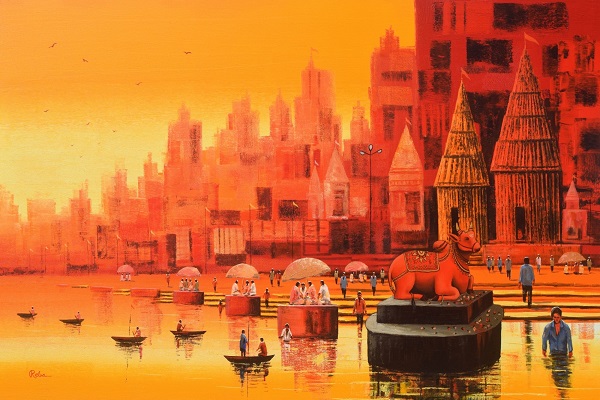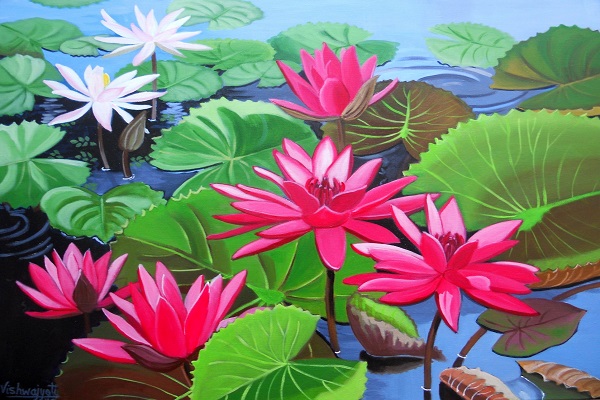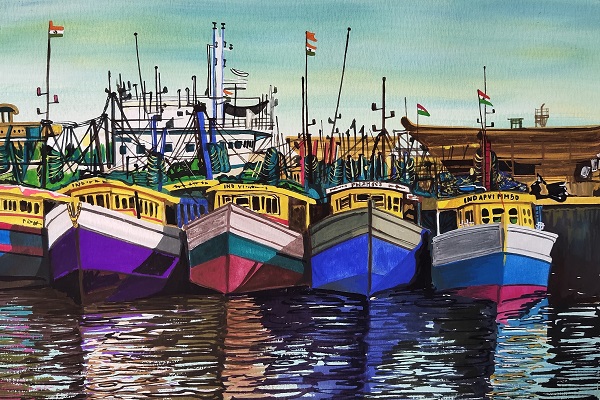
Indian landscape art, characterized by its vibrant palette and evocative portrayals, is a testament to India's thriving cultural legacy and awe-inspiring natural landscapes. From the towering Himalayan peaks to the tranquil backwaters of Kerala, artists have skillfully encapsulated the diverse beauty of the nation's scenery. This blog aims to delve into the captivating world of Indian landscape art. Join us on a mesmerizing journey as we unravel the captivating allure and timeless majesty of Indian landscape paintings.
Origins and Historical Context of Indian Landscape Art
To understand the roots of Indian landscape paintings, we must rewind the clock to ancient times. Unlike Western landscape art, which gained prominence during the Renaissance, Indian landscape art has a much older lineage. It begins with the rich tradition of miniature paintings, with the Mughal Empire playing a pivotal role.
These early Indian art prints often depicted gardens, palaces, and serene landscapes as backdrops to historical and mythological scenes. The art of showcasing nature in all its glory flourished during the 18th and 19th centuries when British colonial artists captured the enchanting vistas of India.
Indian landscape paintings has evolved significantly over the centuries. The colonial period witnessed the works of talented artists like Thomas Daniell and his nephew, William Daniell. Their sketches and paintings of India's landscapes are revered for accuracy and artistic merit.
The Bengal School of Art, a prominent movement in the early 20th century, brought a fresh perspective to landscape art. Artists such as Abanindranath Tagore and Nandalal Bose infused a harmonious blend of Indian and Western styles, resulting in landscapes imbued with a spiritual essence.
Cultural and Artistic Influences on Indian Landscape Paintings
The intricate tapestry of Indian culture has significantly influenced landscape art. The diverse landscapes of India, ranging from the snow-capped Himalayas to the arid Thar Desert, offer a rich source of inspiration.
Furthermore, Indian philosophy and spirituality have profoundly impacted the thematic content of these artworks. The interconnectedness of humans with nature, the concept of "Prakriti" (nature), and the vivid symbolism of elements like rivers and trees all find expression in Indian landscape paintings.
Artists often blend these cultural influences with their perspectives. This resulted in a wide array of interpretations, each as unique as the artist behind the canvas.
Indian landscape paintings depict not merely the physical world but a vivid narrative of India's history, culture, and spirituality. Each brushstroke captures the heart and soul of a nation as diverse as its landscapes, offering viewers a timeless connection to the majesty of India's natural beauty.
Landscape Paintings: Capturing the Essence of Diverse India
India's landscapes are a vivid tapestry of nature's finest work. First, picture the Himalayan peaks, where snow-capped mountains pierce the sky, and pristine valleys lay cradled beneath. Then, venture to the Western Ghats, a lush expanse of emerald hills and rainforests teeming with life. As we travel further south, we'll encounter the tranquil backwaters of Kerala, where palm-fringed waterways shimmer beneath the tropical sun. Next lies the Thar Desert, an expansive expanse of golden dunes that stretch endlessly to the horizon.
Indian artists, with their masterful brushwork, have managed to encapsulate the very soul of these diverse landscapes. In the Himalayas, they've captured the ethereal play of light and shadow on the mountainside. Thus creating a sense of depth and grandeur that's almost palpable. In the Western Ghats, the vibrant greens and cascading waterfalls come alive on the canvas, evoking a sense of serenity and life. The backwaters of Kerala find their way onto the canvas through intricate detailing of houseboats and the dance of sunlight on the water's surface. In the Thar Desert, artists depict the stark beauty of the arid land with a warm, earthy color palette, skillfully conveying the harsh yet captivating environment.
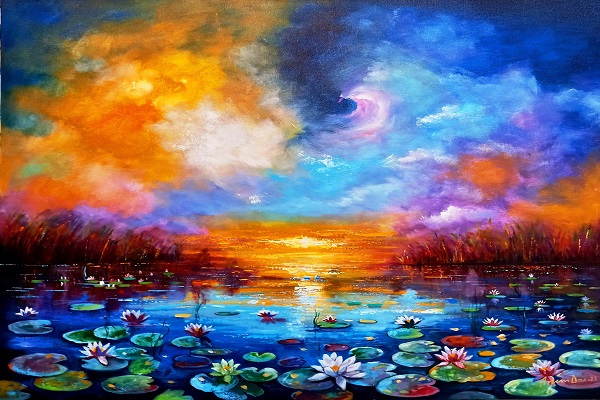
Techniques and Styles in Indian Landscape Paintings
Indian landscape paintings are a realm of boundless creativity where artists weave intricate details, vivid colors, and profound emotions into their canvases. Let's journey through the artistic techniques and styles that have defined Indian landscape art, examining the evolution of these approaches over time.
Detailing Artistic Techniques and Styles
The landscape artists of India employ a myriad of techniques and styles to convey the essence of the country's diverse topography. One of the most prominent styles is the "miniature painting," where artists create intricate, finely detailed scenes on small canvases. These paintings are known for their precision and use of bright, luminous colors.
Conversely, the "Bengal School" of art introduced a more modern and impressionistic approach to landscape art. Pioneered by artists like Abanindranath Tagore, this style aimed to capture the mood and emotions evoked by the landscape rather than replicating it faithfully.
Use of Colors, Brushwork, and Composition
Using colors in Indian landscape paintings is a profound aspect of its appeal. Celebrated for their exceptional skills in the world of painting, these artists exhibit a remarkable ability to expertly wield a broad spectrum of colors, weaving a tapestry of emotions and sensations. The lush green landscapes of the Western Ghats, the golden stretches of Rajasthan's sands, and the enchanting, mist-shrouded peaks of the Himalayas all spring to life through a seamless and poetic dance of colors.
The brushwork in Indian landscape art varies widely. Traditional artists often employ finely detailed and intricate brushwork to create stunningly realistic scenes. On the other hand, modern interpretations may opt for more impressionistic, broad strokes to convey the emotional essence of the landscape.
Composition in Indian art prints is equally diverse. Artists use rivers, mountains, forests, and architectural structures to create balanced and visually captivating compositions. The choice of perspective, such as a bird's eye view or a close-up of nature's details, contributes to the overall impact of the painting.
Evolution of Techniques Over Time
Indian landscape art has undergone a fascinating evolution over the centuries. Early works, dating back to the Mughal era, were influenced by Persian art and featured meticulous detail. The Bengal School introduced more freedom and imagination into the genre as time passed. The post-independence period witnessed a fusion of traditional and contemporary elements, resulting in a vibrant and evolving landscape art scene.
In recent years, artists have embraced experimentation with traditional and new media. Thus pushing the boundaries of what Indian landscape paintings can be. The fusion of styles, techniques, and a deeper connection with the environment continues to shape this art form, making it a dynamic and ever-evolving aspect of India's artistic heritage.
A Glimpse of the Masters
To truly appreciate the art of capturing India's diverse landscapes, one need only look at the works of famous Indian artists. Take Raja Ravi Varma, whose paintings often featured the lush landscapes of Kerala as a backdrop. Raja Ravi Varma's "Landscape with Waterfall" is a true masterpiece, seamlessly whisking viewers away to the heart of the Western Ghats. Similarly, in Abanindranath Tagore's "Himalayan Landscape," we are offered a profound exploration of the Himalayas' understated yet profoundly captivating beauty.
Artists such as these have made an enduring impact on the art world by skillfully transforming India's varied landscapes into timeless works of art, inviting us to traverse the country's terrain with each stroke of their brushes.
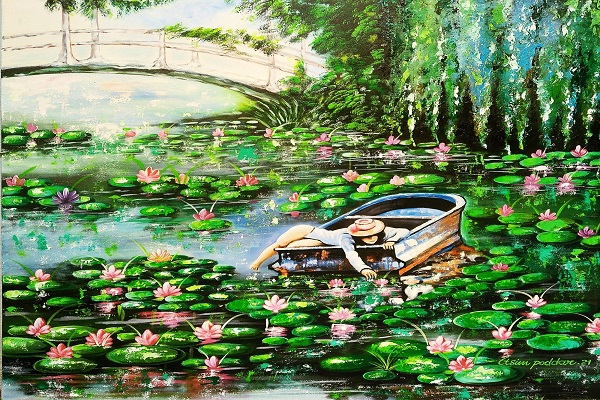
Wrapping Up
Indian landscape paintings are a vibrant and ever-changing testament to the majesty of India's natural beauty, its rich cultural heritage, and the artistic ingenuity of its creators. Each stroke of the brush is a story waiting to be told, an emotion to be shared, and an invitation to explore the breathtaking landscapes of this incredible nation.Explore these beauties at Indian Art Ideas.





















